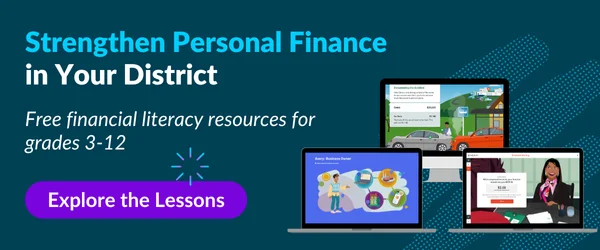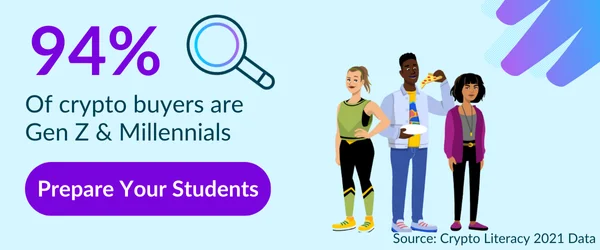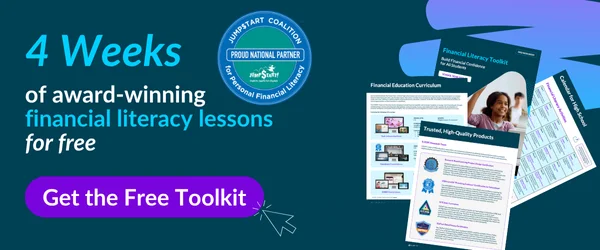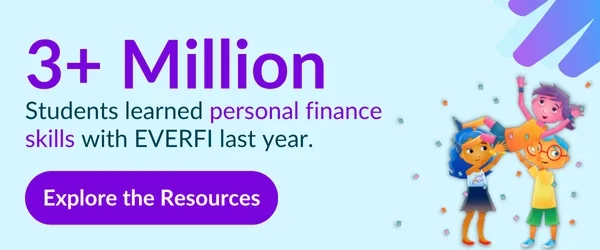- Blog
- Teaching Cryptocurrency in Schools: A Guide for School Districts
Teaching Cryptocurrency in Schools: A Guide for School Districts

Cryptocurrency is no longer considered a trend. It’s here to stay.
Crypto is making long-term impacts on our technological, social, educational, and, of course, financial futures. The Council of Economic Education (CEE) found that 25% of finance and economics teachers are mentioning cryptocurrency in their classes. While over 60% of educators feel unprepared and are seeking professional development on modern finance topics like digital currency.
Our economy is changing. Financial institutions are investing heavily in digital finance education to prepare future investors. Teen interest in digital currencies is strong. In fact, many teens list crypto as a priority investment behind stocks, according to a Wells Fargo study. As an educator, you are in a unique position to prepare students for this future currency. This guide will explain why digital currency education is important, how to use it in your finance curriculum, and how using project-based learning can keep your classroom engaged.
Main Takeaways:
- Crypto needs to be included in financial literacy to prepare students for the future.
- Learning about digital currency may intrigue some students to seek a career in blockchain or financial tech sectors.
- Teaching crypto is a cross-curriculum topic: economics, business, math, finance, computer science, and more.
- Teachers can create real-world, hands-on, activities around cryptocurrency to keep the lessons engaging and fun.
- Everfi’s free Crypto Foundations resource consists of interactive lessons designed to build real-world skills and save teachers time.
Table of Contents
- Why Your District’s Students Should Learn About Crypto
- Benefits of Teaching Kids About Cryptocurrency
- How to Integrate Crypto Into K-12 Curricula
- Cryptocurrency Project Ideas for Students
- Crypto for Kids: FAQs
- Empower Teachers with Everfi’s Free Crypto Resources
Why Your District’s Students Should Learn About Crypto
Cryptocurrency started as an obscure gaming currency back in 2007. Today, cryptocurrency is being used by several nations as currency, including El Salvador, Switzerland and Japan. The U.S. has recently begun exploring crypto’s place in our economy.
While policies and regulations are debated today, your students will be using crypto technology in ways we may not even know yet.
Cryptocurrency for students is essential in 2025. With a strong crypto education, your students will be able to:
- Navigate the world of digital currency
- Spot risks, scams, and crypto fraud
- Gain insight into careers in fintech, coding, and personal finance
- Establish a healthy foundation in risk-reward investment relationships
Parents and students demand more crypto education. Many financial institutions conduct surveys to see how stakeholders would react to crypto topics being taught in school.
“It is encouraging to see that parents are starting to realize the importance of crypto education. With the increasing popularity of cryptocurrencies, it is important for people to understand how they work. And what better place to learn about this new technology than in school?” — Jayson Andrews, CEO of BanklessTimes

Benefits of Teaching Kids About Cryptocurrency
Crypto education can provide multiple benefits, such as modern financial literacy preparedness, STEM skills, career opportunities, and cybersecurity awareness.
Financial Literacy
Demystifying cryptocurrency concepts like blockchain technology, digital wallets, and decentralized finance enables students to make more informed decisions and be aware of potential scams when deciding to purchase crypto. Their strengthened ability to evaluate risks, understand volatility and question new trends will help them make more informed decisions in all areas of their lives.
STEM Skills
Crypto and STEM go hand-in-hand. It never would have come into existence had its creators not had a strong background in STEM.
As students learn about crypto, they’ll also be strengthening their STEM skills in areas like:
- Computer Science: Understanding crypto requires knowing about blockchain technology, the tracking ledger designed to keep things safe and fair. A strong crypto curriculum requires students to explore coding, cryptography, and blockchain logic.
- Math Skills: Crypto reinforces concepts like probability, algorithms, and data analysis.
- Engineering Thinking: The foundational engineering concepts behind crypto require students to think in terms of systems design and optimization.
- Digital Literacy: Exposing students to crypto strengthens their comfort with emerging technologies and prepares them for careers in technology.
Career Opportunities
Alongside STEM skills, students can learn about how companies are hiring crypto experts. Early exposure to crypto education may give students an advantage in careers like blockchain development, financial technology, business, journalism, and personal finance. Some of these careers, especially niche blockchain experts, command six figure salaries.

Cybersecurity
The crypto universe is relatively unregulated with lots of opportunities for bad actors to profit. Understanding how crypto uses encryption to keep people’s money and information safe online and how students can take steps to protect themselves makes them more self-aware and may spark an interest in the ever-growing cybersecurity field.
How to Integrate Crypto Into K-12 Curricula
There are many ways to integrate crypto topics into either a new curriculum or your existing curriculum.
Financial Literacy and Economics
Naturally, cryptocurrency lessons for high school students will be found in personal finance and economics classes. While cryptocurrency isn’t explicitly listed as a standalone topic in the current National Standards for Personal Finance Education, it does include related concepts like digital financial tools and risk management, providing teachers with an opening to include it in their curriculum.
Mathematics and STEM
Schools can easily incorporate crypto into math and elective STEM classes.
Math teachers can use real crypto market data to teach concepts like percentages, graphing, and financial literacy. For example, students could track Bitcoin prices to explore trends, volatility, and exponential growth. It’s a hands-on way to make math feel more relevant and engaging. Colorado’s Department of Higher Education is already exploring blockchain to help students build future-ready skills.
STEM classes can have students simulate the crypto mining process by solving math puzzles that mimic the proof-of-work algorithms that act as a blockchain security.

Social Studies and History
Curriculum in this area can teach students the history of money and the evolution of currency. Students can study the origin of Bitcoin and how it rose to popularity. Students can also debate the regulations of crypto vs. non-regulated digital assets around the world. A fun activity may be to research what impact crypto has had on countries that accept it as currency and what that impact might look like if our country adopted it.
Cryptocurrency Project Ideas for Students
Designing cryptocurrency projects for students is an excellent way to find engaging, hands-on activities for your classroom. We will provide some ideas here but use them as a brainstorming bank because this is not an exhaustive list.
Classroom Token Economy
Students can design their classroom’s custom cryptocurrency. They are tasked with creating its origin, price point, where it can be traded, and how it can be used in the economy. Then you can use the classroom coin (“ClassCoin” — you can use that) to reward classroom achievements like attendance, participation, or good grades. You can task students to track each transaction on a spreadsheet.
Crypto Market Simulation
You can put individuals competing against one another or put students on teams. They can design mock portfolios and invest in simulations tracking actual cryptocurrency assets like Bitcoin, Ethereum, or Dogecoin.
NFT Art Project
Great idea for art class or even geometry! Students can design digital art NFTs (non-fungible tokens) to “trade” with other students. You can even hold competitions to ask students which one would be valued the most.
Future of Crypto Debate
Divide the classroom into two teams. One side argues the positive aspects of cryptocurrency, while the other addresses the concerns. Students can use modern news articles to support their arguments.
Crypto for Kids: FAQs
Can students under 18 trade crypto?
Most investment platforms, including crypto, require investors to be 18 or older to invest. However, students can learn about crypto free of risk at any age. There are also opportunities for kids to invest using custodial accounts under the management of their legal guardian.
Is crypto too risky for students to know about?
Any investment is risky. Students should be taught the relationship between risk and reward for all assets. Students should also be taught about risk tolerance when investing.
How do we address scams?
Scams are an unfortunate part of life. By providing students a safe environment to explore scams we enable them to build their critical thinking skills and confidence without the possibility of negative repercussions.
Empower Teachers with Everfi’s Free Crypto Resources
Cryptocurrency for students is an essential topic in modern classrooms. Teaching crypto can seem overwhelming, however, especially knowing where to start. That’s why we offer a free Crypto Foundations resource. In it, teachers can find standards-aligned lessons that they can quickly implement and assess.
Get started with Crypto Foundations in under five minutes to amplify your curriculum and prepare students for the future!

Jack Woerner is a personal finance educator and consultant. He is a former high school personal finance and economics teacher. Jack designs financial curriculum for organizations all over the globe. He has written guides, articles, and blogs as well as ghostwritten several books about financial literacy. Jack is passionate about teaching personal finance to everyone.
Free for All School Districts
Thanks to partners, we provide our digital platform, training, and support at no cost.
See why 3 out of 5 districts partner with Everfi.

